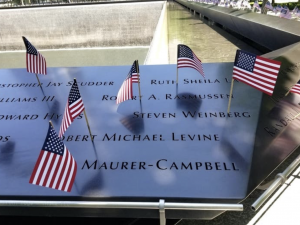Thirty years ago today, we Americans were introduced to large-scale, foreign acts of terrorism here on our shores. On February 26, 1993, an ominous forewarning occurred in lower Manhattan as the World Trade Center (WTC) was targeted for the first time. Arguably, the two large buildings and thousands of lives were spared by the misplacement of heavy explosives. But… instantly, the sacrosanct lands of the United States were no longer immune from targeted attacks.
A 1300-pound bomb was detonated below the North Tower of the WTC complex. It entered the Trade Center’s underground garage hidden in a rented Ryder van. The explosive device was intended to have the North Tower topple into the South Tower, bringing down both buildings and killing tens of thousands of people. The mission failed, although six people were sadly murdered.
A Failed Effort Motivates a Second Attack
The 1993 attack was planned by a group of terrorists including Ramzi Yousef. In November 1997, he would be convicted of carrying out the bombing, along with Eyad Ismoil who allegedly drove the van. Four additional men associated with the attack were previously convicted in 1994. The connection to the eventual destructive attack on the WTC was clear. Yousef’s uncle, Khalid Sheikh Mohammed, who was later considered the principal architect of the 9/11 attacks, provided advice and some funding for the 1993 explosion. Further, Yousef had spent time in Afghanistan at an al-Qaeda training camp before planning the first bombing attack at the WTC.
The failed mission likely propelled Khalid Sheikh Mohammed to seek a more complex effort. The first attack failed because, according to an MSNBC articled penned by Peg Tyre, “the WTC’s architect (told) jurors that if the van had been left closer to the poured concrete foundations, they would have succeeded. The tower would have fallen.” A second, almost unconscionable, act of terror was soon put in motion. That one would not fail.
A Personal View
Almost six years after the 1993 attack, I stood on the unfinished 77th floor of the South Tower along with my fellow managers of Baseline Financial Services. At the time, I was head of sales and marketing. Our success had generated the need for more space. Our lease at 61 Broadway was soon to expire, and we were exploring options. The Port Authority of New York & New Jersey owned the WTC and had spent time and money to better protect the property. Tank traps and other fortifications had been installed at the WTC and surrounding areas in the years after 1993. As we walked around the unfinished floor in early 1999, the attack was a discussion point.
The real estate agent had a Port Authority representative tout all the special changes made to prevent such attacks in the future and to make the two buildings safer from major catastrophes such as large-scale fires. It was reported that they had spent more than $90 million on safety improvements. Evacuation drills were held every six months, and Fire Wardens were recruited on each floor as volunteers to help educate all tenants’ workers in the two towers. According to journalist Dennis Cauchon, in an article for USA Today on December 20, 2001, entitled “For Many on Sept. 11, Survival Was No Accident,” the Port Authority had “added a second source of power for safety equipment, such as fire alarms, emergency lighting, and intercoms. It also built duplicate fire command posts, one in each tower.” It was also reported that the Port Authority had placed batteries in stairwell lights in case of power failure, and installed loudspeakers so that building management personnel could reach tenants in their offices or in the hallways.
In addition to considering all those changes made by the Port Authority, the members of the Baseline operations committee agreed that the other locations we had considered were suboptimal. Further, we knew that cars or trucks with explosives couldn’t get close to this refortified WTC complex. It was unfathomable in 1999 to consider the reality that would unfold in two years time: that human beings would coordinate a terror plot where they could all somehow simultaneously avoid airport security detection and hijack four large commercial airliners from three different airports, while at the same time easily sacrifice their own lives for their sense of some greater purpose.
Two World Trade Center became Home
We moved onto the 77th and 78th floors of the south tower in September 1999. Just two years later, our world was turned upside down on the infamous day known as 9/11. My Baseline colleagues and I lost four wonderful teammates along with other friends and neighbors. Two-thousand nine-hundred seventy-seven innocent souls were murdered that day in four separate attacks. To this day it’s hard to escape the lingering reality of 9/11 and the associated, gut-wrenching “what if” scenarios.

The World Trade Center Memorial for the South Tower. This photograph depicts the corner where my fallen associates are remembered: Jill Maurer Campbell, Ruth Lapin, Bob Levine, and Steve Weinberg.
On this anniversary of the 1993 attack, it is important to recognize that pockets of hatred for, and grievances against, the United States and the free world remain. As we seek a better world with improved mutual understandings, we must be resolute in the protection of our shores: welcoming those who are oppressed in other countries but verifying the credentials of all who seek entry. It is also imperative that we remember the innocent souls lost in those two homicidal attacks.
May we never forget!
Ed Zier
Ed Zier is the former COO of Baseline Financial Services, and the author of the book UNDAUNTED. Published in 2021 by Koehler Books, UNDAUNTED details the true story of Baseline’s employees on 9/11 and their incredible journey in the weeks that followed.



Wonderful essay, EZ. Your perspective is powerful and I agree with your opinions. Your book has a place of honor on my shelf.
Thank you Tom.
Such great perspective on how it is all liked together. Well said Ed.
Thanks Aimee. The fact that it was linked…makes the actual 9/11 attacks extremely unfortunate.
Thank you for writing this
Thanks Rick. Needs to be told… over and over again. Generations over generations tend to forget things.
Thanks for writing about this Ed. 30 years ago, yet my memories of that day are still crystal clear. I remember the bomb blast occurring between 11:30 am and 12 noon. I remember walking down 82 flights of stairs with my colleagues in pitch black darkness in conga-line. I remember the fresh air as we got outside around 4pm.. I remember the NYC firemen who carried a pregnant colleague to the roof so she could be helicoptered to safety later that evening. I remember the news helicopters perilously close to the window next to my office. I remember being terrible soreness in my leg muscles the next day. I thank God the parking lot signage in the basement of WTC was so confusing that the bombers probably got lost when positioning the rental van with the explosives in a less than ideal location so Tower 1 did not topple into Tower 2. And three months or so later when we returned to the office, I remember a colleague saying he thought we were working in the safest building in the world. That, unfortunately turned out not to be the case and 23 former colleagues were killed on 9/11.
Thanks for your heartfelt thoughts Rob. I’m very sorry to learn of your 23 colleagues that perished on 9/11. Your emotions and actions in 1993 paralleled so many stories on 9/11. I believe we easily recall those traumatic moments in our lives that threaten our existence. Life is fleeting. I’m glad you safely avoided harm and continued to lead a wonderful, extended family. May we never forget!